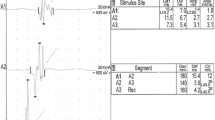Abstract
We present a case of Alexander’s disease (AD) in a Bernese mountain dog. The male dog had a clinical history of tremors of the hind legs and posterior weakness, which deteriorated rapidly to posterior paresis and tetraparesis. After a disease duration of 4 weeks the dog was euthanatized at 13 weeks of age. Macroscopically the brain showed moderate enlargement of the lateral ventricles. Histologically there was marked proliferation of astrocytes with abnormally large cell bodies in the white matter of the brain and the white and gray matter of the spinal cord. In these regions numerous round, club-shaped, or elongated deposits consistent with Rosenthal fibers (RFs) were found. They were most prominent in perivascular, subependymal, and subpial areas where they were perpendicularly arranged. Additionally there was considerable loss of myelin. Immunohistologically the RFs were positive for glial fibrillary acidic protein and αB-crystallin. Unter the electron microscope the RFs were found to be located in the cell bodies and processes of astrocytes and appeared as osmiophilic irregularly formed bodies of uneven size with distinct borders that were tightly associated with glial filaments. The histological, immunohistochemical, and ultrastructural findings of this canine case of AD are identical with those in human cases.
Similar content being viewed by others
References
Arend AO, Leary PM, Rutherford GS (1991) Alexander’s disease: a case report with brain biopsy, ultrasound, CT scan and MR1 findings. Clin Neuropathol 10:122–126
Cole G, De Villiers F, Proctor NSF, Freiman I, Bill P (1979) Alexander’s disease: case report including histopathological and electron microscopic features. J Neurol Neurosurg Psychiatry 42:619–624
Cox NR, Kwapien RP, Sorjonen DC, Braund KG (1986) Myeloencephalopathy resembling Alexander’s disease in a Scottish terrier dog. Acta Neuropathol (Berl) 71:163–166
Escourolle R, DeBaecque C, Gray F, Baumann N, Hauw JJ (1979) Etude en microscopie electronique et neurochimique d’un cas de maladie d’Alexander. Acta Neuropathol (Berl) 45: 133–140
Farrel K, Chuang S, Becker LE (1984) Computed tomography in Alexander’s disease. Ann Neurol 15:605–607
Fankhauser R, Fatzer R, Bestetti G, Deruaz JP, Perentes E (1980) Encephalopathy with Rosenthal fibre formation in a sheep. Acta Neuropathol (Berl) 50:57–60
Garret R, Ames RP (1974) Alexander’s disease. Case report with electron microscopical studies and review of the literature. Arch Pathol 98:379–385
Goebel HH, Bode G, Caesar R, Kohlschütter A (1981) Bulbar palsy with Rosenthal fiber formation in the medulla of a 15-year-old girl. Localized form of Alexander’s disease? Neuropediatrics 12:382–391
Goldman JE, Corbin E (1991) Isolation of a major protein component of Rosenthal fibers. Am J Pathol 139:569–578
Goldman JE, Corbin E (1991) Rosenthal fibers contain ubiquitinated αB-crystallin. Am J Pathol 139:933–938
Head MW, Corbin E, Goldman JE (1993) Overexpression and abnormal modification of the stress proteins αB-crystallin and hsp 27 in Alexander disease. Am J Pathol 143: 1743–1753
Iwaki A, Iwaki T, Goldman JE, Ogomori K, Tateishi J, Sakaki Y (1992) Accumulation of αB-crystallin in brains of patients with Alexander’s disease is not due to an abnormality of the 5′-flanking and coding sequence of the genomic DNA. Neurosci Lett 140:89–92
Kato M, Herz F, Kato S, Hirano A (1992) Expression of stressresponse (heat-shock) protein 27 in human brain tumours: an immunohistochemical study. Acta Neuropathol 83:420–422
Kato S, Hirano A, Umahara T, Llena JF, Herz F, Ohama E (1992) Ultrastructural and immunohistochemical studies on ballooned cortical neurons in Creutzfeld-Jacob disease: expression of αB-crystallin, ubiquitin and stress-response protein 27. Acta Neuropathol 84:443–448
McGrath JT (1980) Fibrinoid leukodystrophy (Alexander’s disease). In: Andrews WJ, Ward BC, Altman HN (eds) Spontaneous animal models of human disease, vol 2. Academic Press, New York, pp 147–148
Neal JW, Cave EM, Shingrao SK, Cole G, Wallace SJ (1992) Alexander’s disease in infancy and childhood: a report of two cases. Acta Neuropathol 84:322–327
Ochi N, Kobayashi K, Maehara M, Nakayama A, Negoro T, Shinohara H, Watanabe K, Nagatsu T, Kato K (1991) Increment of αB-crystallin mRNA in the brain of patients with infantile type Alexander’s disease. Biochem Biophys Res Commun 179:1030–1035
Ogosawara N (1965) Multiple Sklerose mit Rosenthalschen Fasern. Acta Neuropathol (Berl) 5:61–68
Pridmore CL, Baraitser M, Harding B, Boyd SG, Kendall B, Brett EM (1993) Alexander’s disease: clues to diagnosis. J Child Neurol 8:134–144
Richardson JA, Tang K, Burns DK (1991) Myeloencephalopathy with Rosenthal fiber formation in a Miniature Poodle. Vet Pathol 28:536–538
Russo LS, Aron A, Anderson PJ (1976) Alexander’s disease: a report and reappraisal. Neurology 26:607–614
Schochet SS, Lampert PW, Earle KM (1968) Alexander’s disease. A case report with electron microscopic observations. Neurology 18:543–549
Sherwin RM, Berthrong M (1970) Alexander’s disease with sudanophilic leukodystrophy. Arch Pathol 89:321–328
Sorjonen DC, Cox NR, Kwapien RP (1987) Myeloencephalopathy with eosinophilic refractile bodies (RFs) in a Scottish Terrier. J Am Vet Med Assoc 190: 1004–1006
Tomokane N, Iwaki T, Tateishi J, Iwaki A, Goldman JE (1991) Rosenthal Fibers share epitopes with αB-crystallin, glial fibrillary acidic protein, and ubiquitin, but not with vimentin. Am J Pathol 138:875–885
Towfighi J, Young R, Sassani J, Ramer J, Horoupian DS (1983) Alexander’s disease: further light-, and electron microscopic observations. Acta Neuropathol (Berl) 61:36–42
Townsend JJ, Wilson JF, Harris T, Coulter D, Fife R (1985) Alexander’s disease. Acta Neuropathol (Berl) 67:163–166
Vogel FS, Hallervorden J (1962) Leukodystrophy with diffuse Rosenthal fiber formation. Acta Neuropathol (Berl) 2:126–143
Author information
Authors and Affiliations
Rights and permissions
About this article
Cite this article
Weissenböck, H., Obermaier, G. & Dahme, E. Alexander’s disease in a bernese mountain dog. Acta Neuropathol 91, 200–204 (1996). https://doi.org/10.1007/s004010050414
Received:
Accepted:
Issue Date:
DOI: https://doi.org/10.1007/s004010050414




